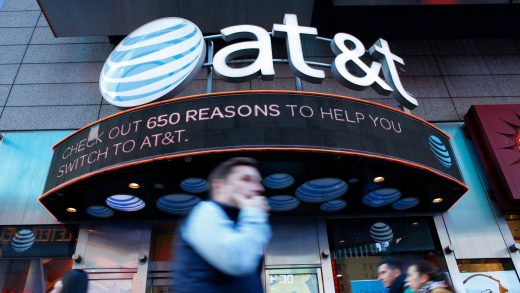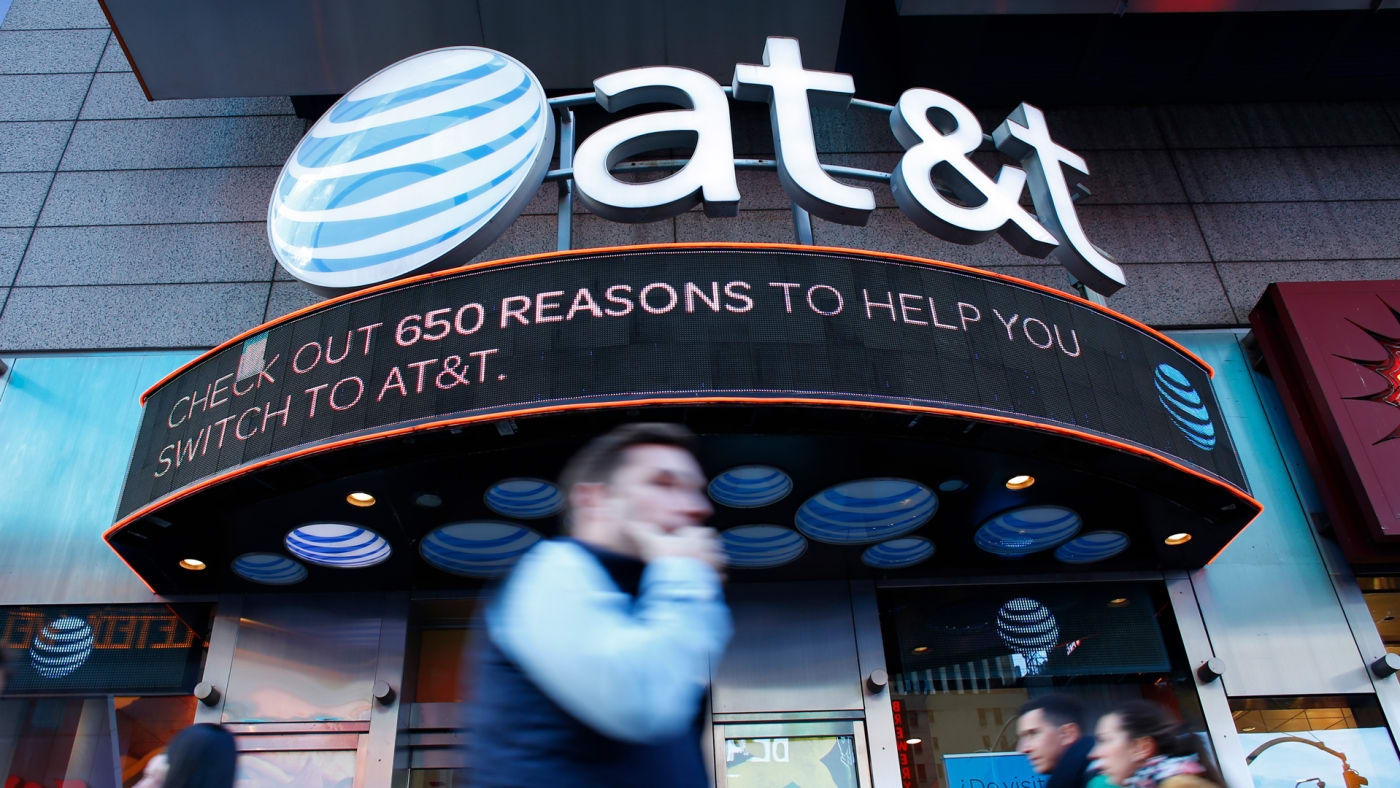Everything AT&T has done in 3 weeks to take on Facebook and Netflix
It took a grueling 18 months for AT&T to acquire Time Warner. But in the few weeks since the deal was announced last month, AT&T has been working at warp speed, rolling out a series of new products and initiatives that show just how serious it is about rewiring its business now that it has in its clutches the content troves of Time Warner—or WarnerMedia, as it’s now called.
The idea behind the $85 billion merger is to marry AT&T’s 100 million-plus mobile, internet, and cable subscribers with WarnerMedia’s content as a way to fight off competition from other carriers, as well as streaming services like Netflix and Hulu. By coming up with new offerings to entice customers, AT&T sees a way to grow its business at a time when the pay-TV business is in decline.
And it wants to come up with those offerings fast. In the first quarter, AT&T reported that it lost 187,000 linear video subscribers and 22,000 wireless customers. Although those numbers have improved from the company’s losses during the same period in 2017, they show how there’s no time to waste when it comes to leveraging Wonder Woman, et al, to turn things around. Since June 12, when the merger was blessed by the Department of Justice, AT&T has introduced a new streaming service, announced another one, bumped up fees, and yes, lost the “Time” in Time Warner.
The question now is: Can it keep up this pace of rapid reinvention? Most of the initiatives that have been announced were quietly in the works over the past several months; AT&T just needed an okay from the government before it could follow through. What remains to be seen is how AT&T will handle the harder innovations, such as coming up with unique and compelling ways for people to consume all of its new content. Simply dangling HBO as a carrot to get people to sign up for a more expensive wireless data plan isn’t exactly a groundbreaking, or creative, solution. How can AT&T and WarnerMedia make this merger not just about massive scale but effective synergy and new approaches?
Here’s everything AT&T has rolled out so far:
1. WatchTV, the $15 skinny bundle
WatchTV is the first and biggest sign so far of what AT&T CEO Randall Stephenson’s vision is for fusing content and distribution.
WatchTV is a “skinny bundle” of cable TV channels, including some from WarnerMedia, such as CNN, TNT, and TBS. Other offerings include AMC, the History Channel, BBC America, and Lifetime. Notably absent are any sports, such as ESPN, or local news channels. The service has 31 networks in all (a mix of 15,000 TV shows and movies), making it a more modest offering than DirecTV Now, or Hulu’s live TV product. But it is also cheaper than those services, at just $15 a month. In fact, it’s the cheapest option available for those wanting to cut the cord. Soon, AT&T will be adding six more Viacom channels, including Comedy Central, NickToons and MTV 2 (though no regular MTV).
“Our goal is to completely change how content is created, distributed, and consumed and [WatchTV] is really the first of many steps,” said David Christopher, president of AT&T Mobility and Entertainment upon the product’s launch.
The big perk, or innovation, here, is that subscribers to two, new unlimited data AT&T plans will get WatchTV for free. Anyone else (even non-AT&T subscribers) will have to pay the $15. The idea is that, after luring subscribers to these new plans, AT&T can then get valuable data on them and serve them up personalized content and, more importantly, ads.
As well as its most urgent: The product was revealed just days after the merger was announced. By rolling out a second streaming service so quickly—AT&T already has DirecTV Now—the company is showing how streaming is top of mind in its plans to reinvent itself.
2. About Those New Unlimited Plans . . .
The two new, unlimited plans are AT&T Unlimited & More, which costs $70 a month (up from $65 from the company’s previous basic unlimited offering) for a single line and $160 for four lines; and AT&T Unlimited & More Premium, which is $80 a month for one line and $190 for four lines. Subscribers to these packages will get a $15 credit to DirecTV as well as access to WatchTV. They also get unlimited 4G LTE and video streams in standard definition.
These plans replace AT&T’s previous unlimited plans (Unlimited Plus Enhanced and Unlimited Choice Enhanced), both of which offered free HBO, which AT&T now owns. Now, if you’re an Unlimited & More Premium subscriber, you can add on HBO (or your choice of one of a list of premium channels like Starz and Showtime, as well as services like Amazon Music) for no charge. But if you’re only an Unlimited & More user: Sorry. Though those that wish to remain on the older plans and keep HBO may do so.
The move shows how AT&T is using HBO to more savvy effect. HBO has always been considered the “crown jewel” of Time Warner, given its portfolio of pedigreed shows like Game of Thrones and Big, Little Lies. Rather than just toss it out to any old customer, AT&T is now withholding it and using it to get subscribers to pony up for its most expensive plan. By adding WatchTV to the packages, AT&T is further differentiating itself from Verizon and T-Mobile.
3. Pay Up for DirecTV Now
With the economically priced WatchTV up and running, AT&T felt justified in raising the price of its more robust streaming offering, DirecTV Now, to $40 a month from $35 a month. The move comes amid a slew of other price hikes amongst the streaming services—YouTube and Sling TV both recently upped their prices to $40 and $25, respectively.
The change puts more of a distinction between DirecTV and WatchTV—one’s the cheap, no-frills one; one’s the more premium—but also keeps DirecTV’s price in line with its competitors. Forty bucks has been identified as the “sweet spot” for streaming skinny bundles. It also helps AT&T keep up with the rising cost of content licenses, a burden that makes it hard for all of these services to turn a profit given that most have a relatively low number of subscribers—DirecTV has 1.5 million. The Motley Fool reported that the average DirecTV Now subscriber generates an estimated $31 a month for AT&T. Yet content costs alone for each subscriber are $30 a month. The new price uptick will help AT&T improve its balance sheet.
4. A Quiet Money Grab
As noted by BTIG analyst Walt Piecyk last week, AT&T quietly doubled an “administrative fee,” a tiny line item that appears at the bottom of customers’ bill, to $1.99 a month from 76 cents. Piecyk did the math, calculating that with 65.5 million monthly customers, the higher fee, which doesn’t apply to prepaid accounts, could generate $800 million a year.
The move underscores how much pressure AT&T is under to pay down its debt—a reported $180 billion—and how it seems to be reaching behind the sofa pillows in search of, literally, pennies, in this effort. Following the merger, Moody’s Investor Services said that AT&T was “weakly positioned” to support its debt and asked the company to create “more forceful, public, and specific” ways to improve its balance sheets.
For its part, AT&T said that the shift was simply a routine business procedure. An AT&T spokesman told The Verge: “This is a standard administrative fee across the wireless industry, which helps cover costs we incur for items like cell site maintenance and interconnection between carriers.”
5. Leaning into the Digital Ad Space
Another major incentive for the merger with Time Warner was to leverage all of the data that AT&T has on its subscribers to serve up more effective (and lucrative) advertising. Particularly, mobile digital advertising, a rapidly growing market that is dominated by Google and Facebook and that companies like AT&T and Verizon are eager to start taking a bigger bite of.
This explains why AT&T shelled out a reported $1.6 billion to buy AppNexus, a company that operates one of the biggest online ad exchanges; i.e. a marketplace that connects digital publishers with ad agencies and allows the latter to buy targeted ads across an array of digital platforms. The company is a leader in the digital ad space, with backing from WPP, investment firm TCV and News Corp.
AppNexus will give AT&T a way to compete against Facebook and Google for digital ad dollars, and help it leverage its broader inventory of ad space, now that it owns TNT, TBS, and CNN. The idea is to help advertisers buy ads across these sites that are targeted to customers based on their habits and interests. So an advertiser interested in reaching 20-year-old males who watch Game of Thrones and live in an urban environment will be easy to target with AT&T’s data and AppNexus’s technology.
6. More Content, More Ad Opportunities
AT&T’s buying spree continues with its plans to buy Otter Media, the online video company that it already owned a 50% stake in. The other half of the company is owned by The Chernin Group. Each has invested $500 million in the company, putting its value at over $1 billion. The deal is expected to close later this summer.
A digital holding company of sorts, Otter oversees a bunch of millennial-skewing digital entities like Crunchyroll, an anime subscription service with 1 million subscribers; Reese Witherspoon’s Hello Sunshine; the production studio Gunpowder & Sky; and the multichannel network Fullscreen. AT&T’s part ownership in the company means that it has already been selling ads on all of those platforms. Once AT&T controls it outright, and has the engine of AppNexus behind it, expect that advertising to go into overdrive.
AT&T can also leverage Otter’s content, perhaps offering it on WatchTV as a way to lure younger people to sign up. Or packaging it with other WarnerMedia content to build new brands.
7. Exploiting its cache of DC superheroes
One of WarnerMedia’s most valuable content assets is DC Entertainment, the umbrella group that oversees all of the movies, TV shows, and other entertainment assets related to the iconic comic book company. It’s Warner’s answer to Marvel, though to date the company has lagged behind in that race, watching Marvel become one of Hollywood’s most consistently successful purveyor of hits like Black Panther, The Avengers, and on and on. Although DC has shown signs of revving its sputtering engines, most notably with last year’s Wonder Woman, the company is in need of more synergistic oversight, and it looks like AT&T is going to make sure that happens.
Last week the company announced that a new DC Universe subscription streaming service will be launching, offering fans not just access to DC movies and TV shows, but also a digital library of comics that fans can also download and read offline. The titles will rotate but at launch will include ones from as far back as 1938 as well as more recent books like Cyborg and Deathstroke. (Notably, Marvel launched a subscription service for digital back issues back in 2007.)
On the movie side, the service will include Batman Begins, The Dark Knight, and the original Superman, as well as all of the sequels. TV series will include Batman: The Animated Series, Static Shock, and Teen Titans. There will also be original exclusives.
The message here is that AT&T is serious about taking on Netflix, and it’s thinking creatively about how it’s going to do that. By fusing viewable and readable entertainment, this service will attract a wider swath of fans and can drive comic book lovers towards its movies and TV shows and vice versa. It’s something that Disney could think about as it prepares to unroll its own entertainment app in 2019.
(11)



